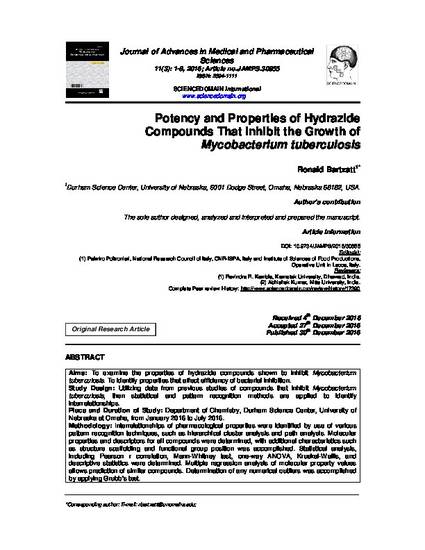
Aims: To examine the properties of hydrazide compounds shown to inhibit Mycobacterium tuberculosis. To identify properties that affect efficiency of bacterial inhibition.
Study Design: Utilizing data from previous studies of compounds that inhibit Mycobacterium tuberculosis, then statistical and pattern recognition methods are applied to identify interrelationships.
Place and Duration of Study: Department of Chemistry, Durham Science Center, University of Nebraska at Omaha, from January 2016 to July 2016.
Methodology: Interrelationships of pharmacological properties were identified by use of various pattern recognition techniques, such as hierarchical cluster analysis and path analysis. Molecular properties and descriptors for all compounds were determined, with additional characteristics such as structure scaffolding and functional group position was accomplished. Statistical analysis, including Pearson r correlation, Mann-Whitney test, one-way ANOVA, Kruskal-Wallis, and descriptive statistics were determined. Multiple regression analysis of molecular property values allows prediction of similar compounds. Determination of any numerical outliers was accomplished by applying Grubb’s test.
Results: Mycobacterium tuberculosis inhibiting compounds contained either an aromatic ring or were non-aromatic structures (no ring). There was weak negative correlation of MIC to formula weight. The average formula weight, polar surface area, and Log P, is 183.55 grams/mole, 63.70 A2, and 0.768, respectively. Values of MIC ranged from 14.7 µg/mL to 100 µg/mL. Extent of bacterial inhibition was similar between aromatics to non-aromatics. No outliers were identified by Grubb’s test for all values of MIC taken together. Path analysis showed polar surface area to have most effect on MIC.
Conclusion: The measured level of growth inhibition MIC, showed strong positive relationship to polar surface area, number of hydroxyl and amine groups, oxygen and nitrogen atoms. Two aromatic compounds having a pyridine ring were found to be most similar to isoniazid. Aromatic and non-aromatic compounds showed similar levels of bacterial inhibition overall.
Available at: http://works.bepress.com/drronald-bartzatt/12/

© 2016 Bartzatt; This is an Open Access article distributed under the terms of the Creative Commons Attribution License (http://creativecommons.org/licenses/by/4.0), which permits unrestricted use, distribution, and reproduction in any medium, provided the original work is properly cited.
DOI : 10.9734/JAMPS/2016/30855
This article was originally published here: http://www.sciencedomain.org/abstract/17390